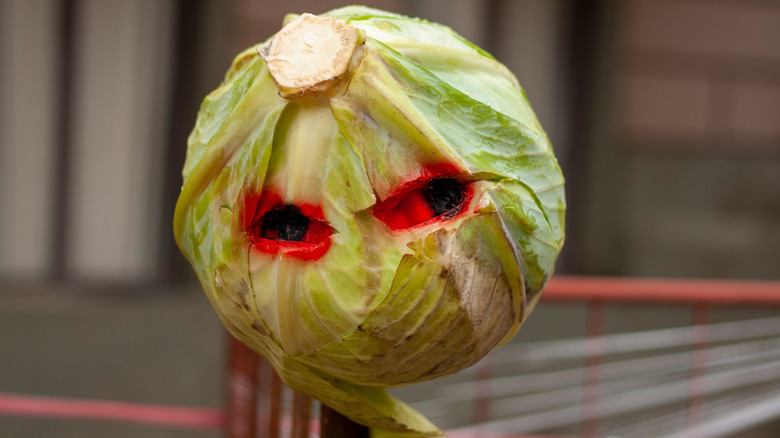The Vegetable People Think Has Supernatural Powers On Halloween
In addition to popular Halloween candies (and the boozy drinks that pair with them), there are traditional food-based Halloween party games like bobbing for apples and donuts on a string. Then there's the controversial treat that is candy corn (which actually has some fancy flavors among its colorful layers). Many All Hallows' Eve partygoers also share scary-themed potluck dishes, like mummy-wrapped hot dogs and monster foot meatloaf. And did you know that cabbage — arguably one of the least popular members of the vegetable community — once reigned over Halloween traditions?
The vegetable was a component of colcannon, a traditional Irish dish popularly consumed at Halloween. It became an entrée Americans ate on Halloween in the 1800s after immigrants brought the tradition with them. Colcannon wasn't just something one ate at dinner, either — it was a fortune-telling food. The Irish would hide various items in the dish before cooking it, and whatever bauble turned up in your portion heralded your fortune for the coming year. For instance, finding a coin meant you would become rich. Finding a thimble in the grub meant you would never be married.
Young, unmarried women also believed pulling a cabbage out of a field on Halloween night could reveal details about their future spouse. If the veggie came up with a great deal of dirt clinging to its roots, it meant a wealthy husband was in the girl's near future. A withered-looking cabbage stalk signaled that its puller-upper was going to wed a widower.
The mischief-making of cabbage night
Believe it or not, the humble cabbage also has its own holiday, with accompanying age-old traditions that are still carried on in some parts of the world. Known as "cabbage night," the occasion was sometimes originally celebrated on Halloween — though, more commonly, it is observed the night before, on Halloween eve. It's also known by the names "cabbage stump night," "cabbage stalk night," "mischief night," and "devil's night." The main component of the holiday is committing acts of mischief (a forerunner for the "trick" part of trick or treat).
Cabbage night is said to have originated with that other tradition of pulling up cabbage plants to learn about one's future. Once a young girl had divined her romantic fortune from the cabbage plant, she would hurl the vegetable against the door of the farmhouse whose field she'd taken it from and then run. Other forms of mischief evolved, with young people leaving rotten vegetables on porches or smearing them on people's windows, unhinging farm gates and letting the livestock run loose — or even outright stealing the gates and hiding them.
Cabbage night has been traced to both Scottish and Dutch origins as well as having roots in Great Britain. The tradition is still carried on in parts of the United States, Canada, and England, with young people committing acts of trickery and mischief — though the presence of cabbage seems to have vanished, being replaced with more modern pranking tools like toilet paper and shaving cream.


